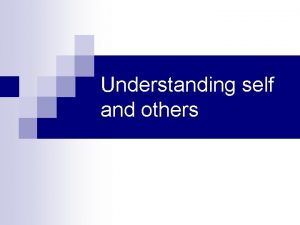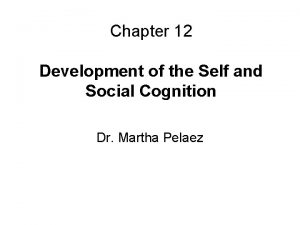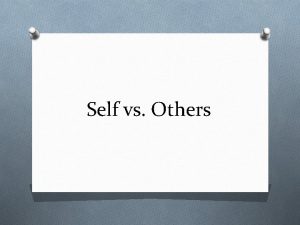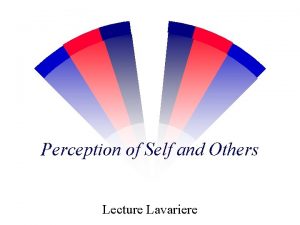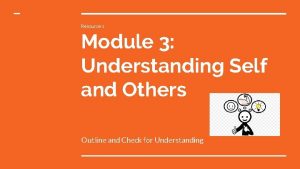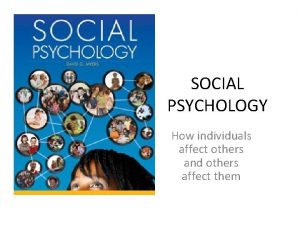Understanding self and others The self n n























- Slides: 23

Understanding self and others

The self n n Answers the question ‘who am I? ’ Meanings attached to a person by self and others that are based on personal characteristics and on people’s social roles and membership in various groups Person can have multiple selves stemming from a variety of identities (Self-pluralism) Ideal/possible self

The self n Product of ¨ What you are ¨ What society expects you to be ¨ What experiences you have and how you deal with them

Self-presentation/impression management: Revealing yourself to others n n n Self-consciousness – the process of knowing oneself Self monitoring - what do you present and why Presenting your true self - makes one vulnerable, so we prefer to act according to social expectations, wear masks and remain enigmas ¨ Assumption of maturity and sensitivity ¨ Of course, sometimes even we do not know our true selves (cf self-consciousness)

Johari window n n n The most useful model to describe the process of human interaction, more specifically of giving and receiving feedback Model depicts communication windows through which feedback is given and received Through feedback and disclosure, you can reveal more about yourself to others and learn more about yourself from others

Johari window model 1 Known by others open/free/public arena area Unknown by self Ask Feedback solicitation Known by self 2 blind area Tell hidden/facade area Unknown by others 3 Shared Discovery Self-discovery Self- disclosure/exposure Others’ observation unknown area 4

Principles of change in the Johari window A change in one quadrant affects other quadrants n It takes energy to hide/deny/be blind to behaviour that is involved in interaction n Trust increases awareness n Forced awareness is undesirable and usually ineffective n The smaller the open area, the poorer the communication n

n n Interpersonal learning means a change has taken place so the Q 1 is larger and one or more of the other quadrants also has grown smaller. Working with others is facilitated by a large enough area of free activity. An increased Q 1 means more of the resources and skills in the relationships can be applied to a task. There is universal curiosity about the Unknown area, but is held in check by custom, social training and diverse fears. Sensitivity means appreciating the covert aspect of behaviour, in quadrant 2, 3 and 4, and respecting the desire of others to keep them so.

Under Condition of Self Disclosure 2 1 3 4 Under Condition of Feedback 1 3 2 4 Under Condition of Self Disclosure and Feedback 1 3 2 4 http: //saweb. weber. edu/elibrary/Structured. Experience/PDF/P-FB-1. pdf

Initial phase of group interaction Open H i d d e n Blind Unknown Later phase of group interaction Blind Open Unknown Hidden

Feedback n Purpose of feedback ¨ Helps us see ourselves as others see us ¨ Others learn how we see them ¨ In so doing, it helps us move towards our goals n Presupposes a caring, trusting environment ¨ Which reduces defensiveness ¨ Which maximises personal growth n The desire for feedback is often off-set by the fear of asking for such information

The appropriate way n Feedback should be given such that the person receiving it ¨ Hears it in the most objective, least distorted way possible ¨ Understands it ¨ Retains the choice of using/not using it n People need to be trained to give feedback ¨ Should be given such that the recipient preserves his/her self-esteem

n Indirect versus direct expression of feelings ¨ Indirect is safer because it is ambiguous and offers an escape from commitment and rejection n Description versus interpretation of behaviour ¨ Description focuses on observable aspects whereas interpretation involves attributing intention and could be wrong n Non-evaluative versus evaluative feedback ¨ Non-evaluative looks at behaviour rather than personal worth and refrains from value-judgments n Specific versus general feedback ¨ Specific change gives you an opportunity to know what to

n Freedom of choice to change versus pressure to change ¨ Freedom of choice to change means that the decision to act on the feedback is voluntary rather than imposed n Immediate versus delayed timing ¨ Immediate feedback is most effective since memory is vivid n External versus group feedback ¨ Contingent n on circumstances Solicited versus imposed feedback ¨ Solicited is more useful since recipient is open

n Modifiable versus unmodifiable behaviour ¨ Conscious n desire to change is critical Motivation to help versus motivation to hurt ¨ Displacement and conflict and projection precipitate harm Data-based versus impressionistic n Positive and negative versus completely negative n Suggestive versus prescriptive n Constructive versus destructive n

Receiving feedback Elicit versus wait n Listening and self-analysis versus denial and rationalisation n Clarifying versus assuming n

References Assigned course readings n http: //www. noogenesis. com/game_theory/ johari/johari_window. html for Johari window n

Benefits of knowing oneself n Self-awareness promotes personal growth, which in turn enhances overall functioning (including work performance)

Self-consciousness: The process of knowing oneself Existentialist orientation coupled with personal courage and conviction n Conducive socio-cultural environment n Living comfortably with complexity and contradiction n Willingness and ability to change n Time and energy for introspection n

Johari Window: The Open-Receptive Person Known To Self Unknown To Self Known To Others Open/Public Blind Spot Hidden/Facade Area Unknown To Others The open-receptive person has a large public area, reflecting someone who is open about him/herself and receptive to feedback from others. This is the person who has a clear self-image and enough confidence in who he/she is to be visible to others. If in a management role, the openreceptive person has employees who tend to feel respected and encouraged to grow.

Johari Window: The Pumper Known To Self Known To Others Unknown To Self Open/Public Blind Spot Hidden/Facade Area Unknown To Others The pumper has a large hidden area, reflecting someone who keeps information with him/herself. This is a person who is always asking for information and giving little in return – the game player. If the pumper is in a management role, employees tend to feel defensive with and resentful of this individual.

Johari Window: The Blabbermouth Known To Self Unknown To Self Known To Others Open/ Public Blind Spot Hidden/ Facade Area Unknown To Others The blabbermouth has a large blind area, reflecting someone who talks a lot but does not listen too well. This is the person who is pre-occupied with him/herself and doesn't know when to keep quiet. If the blabbermouth is in a management role, employees tend to get annoyed with this person and eventually will either actively or passively learn to shut him/her up.

Johari Window: The Hermit Known To Self Known To Others Unknown To Self Open/ Public Blind Spot Hidden/ Facade Area Unknown The hermit has a large unknown area, reflecting a lack of self-knowledge and understanding. This is a person you can’t figure out. The hermit’s behaviour tends to be unpredictable and securityoriented. If in a management role, employees tend to feel insecure and confused about expectations.
 Slidetodoc.com
Slidetodoc.com Self ideal example
Self ideal example I wandered lonely as a cloud figures of speech
I wandered lonely as a cloud figures of speech Managing self and others
Managing self and others Development of self and social understanding
Development of self and social understanding Hình ảnh bộ gõ cơ thể búng tay
Hình ảnh bộ gõ cơ thể búng tay Bổ thể
Bổ thể Tỉ lệ cơ thể trẻ em
Tỉ lệ cơ thể trẻ em Gấu đi như thế nào
Gấu đi như thế nào Tư thế worm breton là gì
Tư thế worm breton là gì Chúa yêu trần thế
Chúa yêu trần thế Các môn thể thao bắt đầu bằng tiếng nhảy
Các môn thể thao bắt đầu bằng tiếng nhảy Thế nào là hệ số cao nhất
Thế nào là hệ số cao nhất Các châu lục và đại dương trên thế giới
Các châu lục và đại dương trên thế giới Công thức tiính động năng
Công thức tiính động năng Trời xanh đây là của chúng ta thể thơ
Trời xanh đây là của chúng ta thể thơ Mật thư tọa độ 5x5
Mật thư tọa độ 5x5 Phép trừ bù
Phép trừ bù Phản ứng thế ankan
Phản ứng thế ankan Các châu lục và đại dương trên thế giới
Các châu lục và đại dương trên thế giới Thể thơ truyền thống
Thể thơ truyền thống Quá trình desamine hóa có thể tạo ra
Quá trình desamine hóa có thể tạo ra Một số thể thơ truyền thống
Một số thể thơ truyền thống
